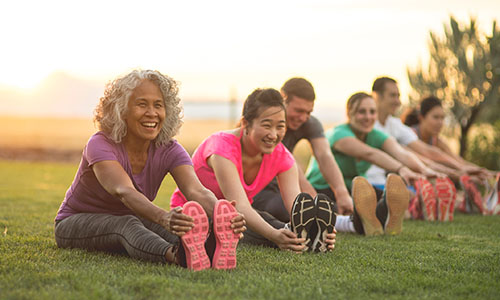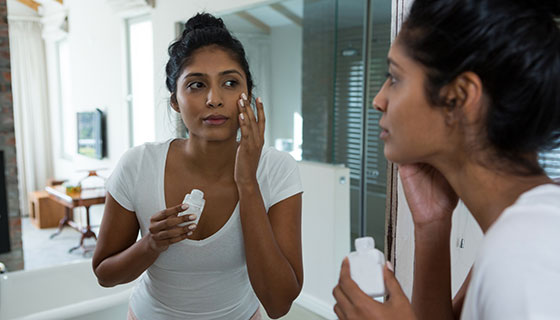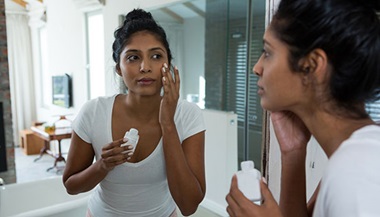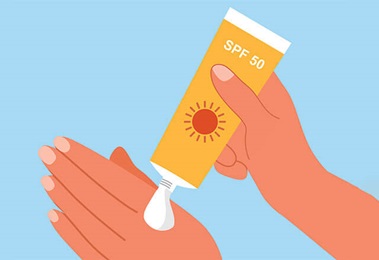Sun Safety
Sun safety for the entire family
Everybody needs some sun exposure to produce vitamin D (which helps calcium absorption for stronger and healthier bones). But unprotected exposure to the sun's ultraviolet (UV) rays can cause damage to the skin, eyes, and immune system. It can also cause cancer. There are other contributing factors such as heredity and environment. But sunburn and excessive UV light exposure do damage the skin. This damage can lead to skin cancer or premature skin aging (photoaging).
What does tanning do to the skin?
Tanning is the skin's response to UV light. When UV rays reach the skin, the skin makes more melanin. Melanin is the color (pigment) that causes tanning. Tanning does not prevent skin cancer.
What is ultraviolet radiation?
Energy from the sun reaches the earth as visible, infrared, and ultraviolet (UV) rays.
-
Ultraviolet A (UVA) is made up of wavelengths 320 to 400 nm (nanometers) in length.
-
Ultraviolet B (UVB) wavelengths are 280 to 320 nm.
-
Ultraviolet C (UVC) wavelengths are 100 to 280 nm.
Only UVA and UVB ultraviolet rays reach the earth's surface. The earth's atmosphere absorbs UVC wavelengths.
-
UVB rays cause a much greater risk of skin cancer than UVA.
-
But UVA rays cause aging, wrinkling, and loss of elasticity.
-
UVA also increases the damaging effects of UVB, including skin cancer and cataracts.
In most cases, ultraviolet rays react with melanin. This is the first defense against the sun. That’s because melanin absorbs the dangerous UV rays that can do serious skin damage. A sunburn develops when the amount of UV damage exceeds the protection that the skin's melanin can provide. A suntan represents the skin's response to injury from the sun. A small amount of sun exposure is healthy and pleasurable. But too much can be dangerous. Measures should be taken to prevent overexposure to sunlight. These preventive measures can reduce the risks of cancers, premature aging of the skin, the development of cataracts, and other harmful effects.
#TomorrowsDiscoveries: Protecting Against UV Radiation – Anna Chien, M.D.
Dr. Anna Chien, dermatologist and Co-Director of the Johns Hopkins Department of Dermatology’s Cutaneous Translational Research Program, and her team have discovered that visible light can cause skin inflammation and skin discoloration.
How can you protect yourself against the sun's harmful rays?
The best way to protect yourself against the damaging effects of the sun is to limit exposure and protect your skin.
The best way to prevent sunburn in children over 6 months old is to follow these tips from the American Academy of Dermatology:
-
Generously apply a broad-spectrum water-resistant sunscreen with an SPF (Sun Protection Factor) of at least 30 to all exposed skin. Broad spectrum means the sunscreen protects you from both UVA and UVB rays. Re-apply about every 2 hours and after swimming or sweating.
-
Wear protective clothing such as a long-sleeved shirt, pants, a wide-brimmed hat, and sunglasses, whenever possible. Look for clothing with a UV protection factor (UPF) or made of a tightly woven fabric.
-
Seek shade when appropriate. Remember that the sun's rays are strongest between 10 a.m. and 4 p.m. If your shadow is shorter than you are, seek shade.
-
Use extra caution near water, snow, and sand. They reflect the damaging rays of the sun. This can increase your chances of sunburn.
-
Get vitamin D through a healthy diet that may include vitamin supplements.
-
Do not use tanning beds. Ultraviolet light from the sun and tanning beds can cause skin cancer and wrinkling. If you want to look tan, try using a self-tanning product. But also use sunscreen with it.
-
Protect your lips with lip balm with at least SPF 15.
Examine your entire skin on a regular basis. If you notice anything changing, growing, or bleeding on your skin, see a healthcare provider right away. Skin cancer is very treatable when caught early.
Remember, sand and pavement reflect UV rays even while under an umbrella. Snow and water are also good reflectors of UV rays. Reflective surfaces can reflect most of the damaging sun rays.
Also take special care to buy protective eyewear for you and your children. Choose sunglasses with labels stating they provide UV protection.
Remember that many over-the-counter and prescription medicines increase the skin's sensitivity to UV rays. So it’s possible to develop a severe sunburn in just minutes when taking certain medicines. Read medicine labels carefully and use extra sunscreen as needed.
What are sunscreens?
Sunscreens protect the skin against sunburns and play an important role in blocking the penetration of ultraviolet (UV) radiation. But no sunscreen product blocks UV radiation 100%.
Terms used on sunscreen labels can be confusing. The protection provided by a sunscreen is indicated by the sun protection factor (SPF) listed on the product label. A product with an SPF higher than 15 is recommended for daily use. Sunscreens contain ingredients that help absorb UV light. Sunblocks contain ingredients such as zinc oxide and titanium dioxide that physically scatter and reflect UVB light. Keep in mind that not all sunscreens protect against UVA rays. Look for products that have broad-spectrum coverage that includes protection from UVA rays.
How to use sunscreens
A sunscreen protects from sunburn and minimizes suntan by absorbing or reflecting UV rays. Using sunscreens correctly is important in protecting the skin. Consider the following recommendations:
-
Choose a sunscreen for children and test it on your child's wrist before using. If your child develops skin or eye irritation, choose another brand. Apply the sunscreen very carefully around the eyes.
-
Choose a broad-spectrum sunscreen that filters out both ultraviolet A (UVA) and ultraviolet B (UVB) rays.
-
Apply sunscreens to all exposed areas of skin, including easily overlooked areas. This includes the rims of the ears, the lips, the back of the neck, and tops of the feet.
-
Use sunscreens for all children over 6 months old. It doesn’t matter what skin or complexion type the child has. All skin types need protection from UV rays. Even dark-skinned children can have painful sunburns.
-
Apply sunscreens 30 minutes before going out into the sun to give it time to work. Use it liberally and reapply it every 2 hours after being in the water or after exercising or sweating. Sunscreens are not just for the beach. Use them when you are working in the yard or playing sports.
-
Use a waterproof or water-resistant sunscreen and reapply it after swimming or sweating heavily.
-
Using a sunscreen with SPF of 20 to 30 offers substantial protection from sunburn and prevents tanning. High SPF sunscreens protect from burning for longer periods of time than sunscreens with a lower SPF. SPF 15 blocks 93% of the UVB and SPF 30 blocks 97%. Talk with your older child or teen about using sunscreen and why it's important. Set a good example for them by using sunscreen yourself.
-
Teach your teen to avoid tanning beds and salons. Most tanning beds and salons use ultraviolet-A bulbs. Research has shown that UVA rays may contribute to premature skin aging and skin cancer.
Sign Up for Our Free Newsletter

One of the best things you can do to protect and improve your health is to stay informed. Your Health is a FREE e-newsletter that serves as your smart, simple connection to the world-class expertise of Johns Hopkins.






